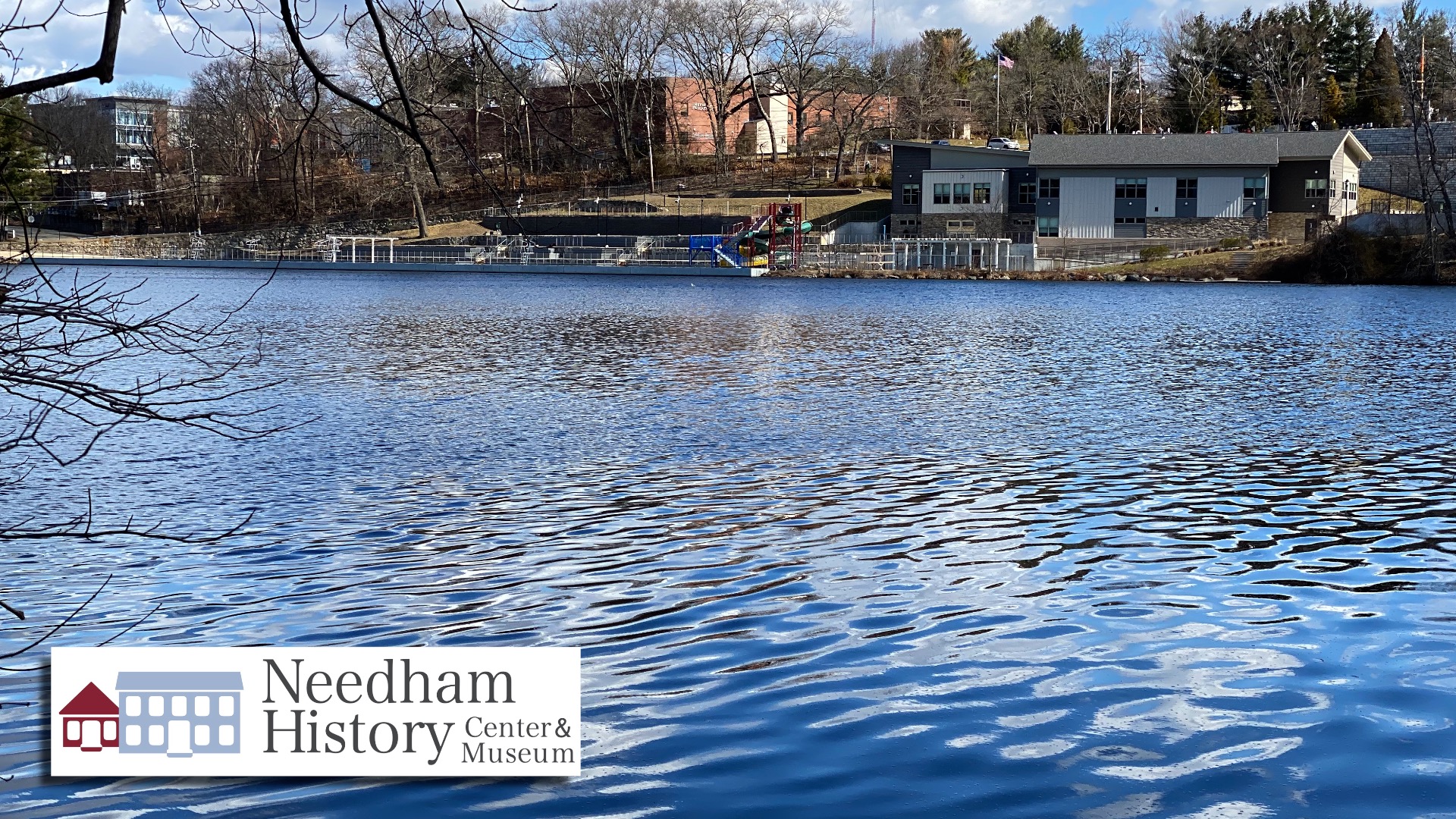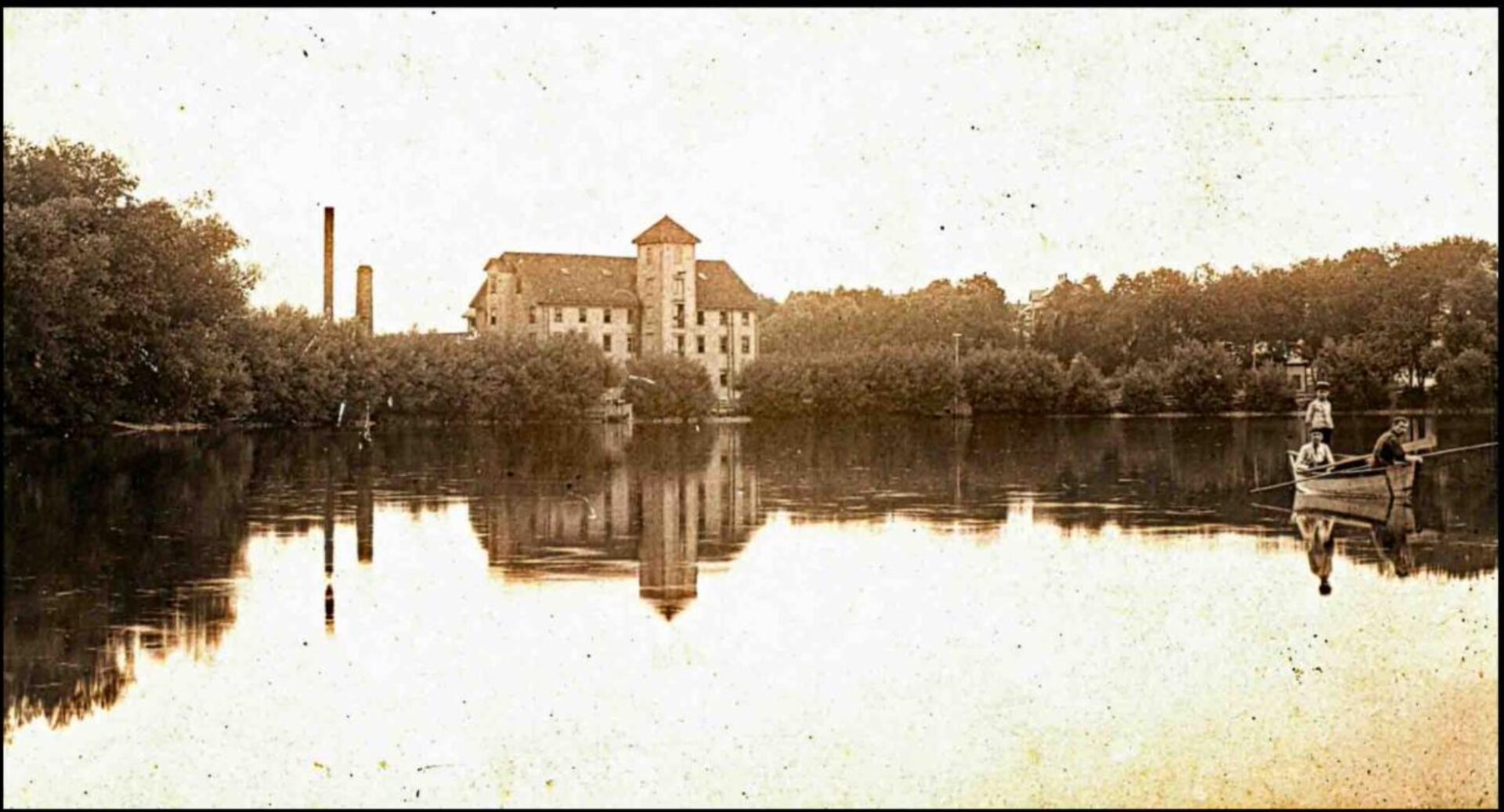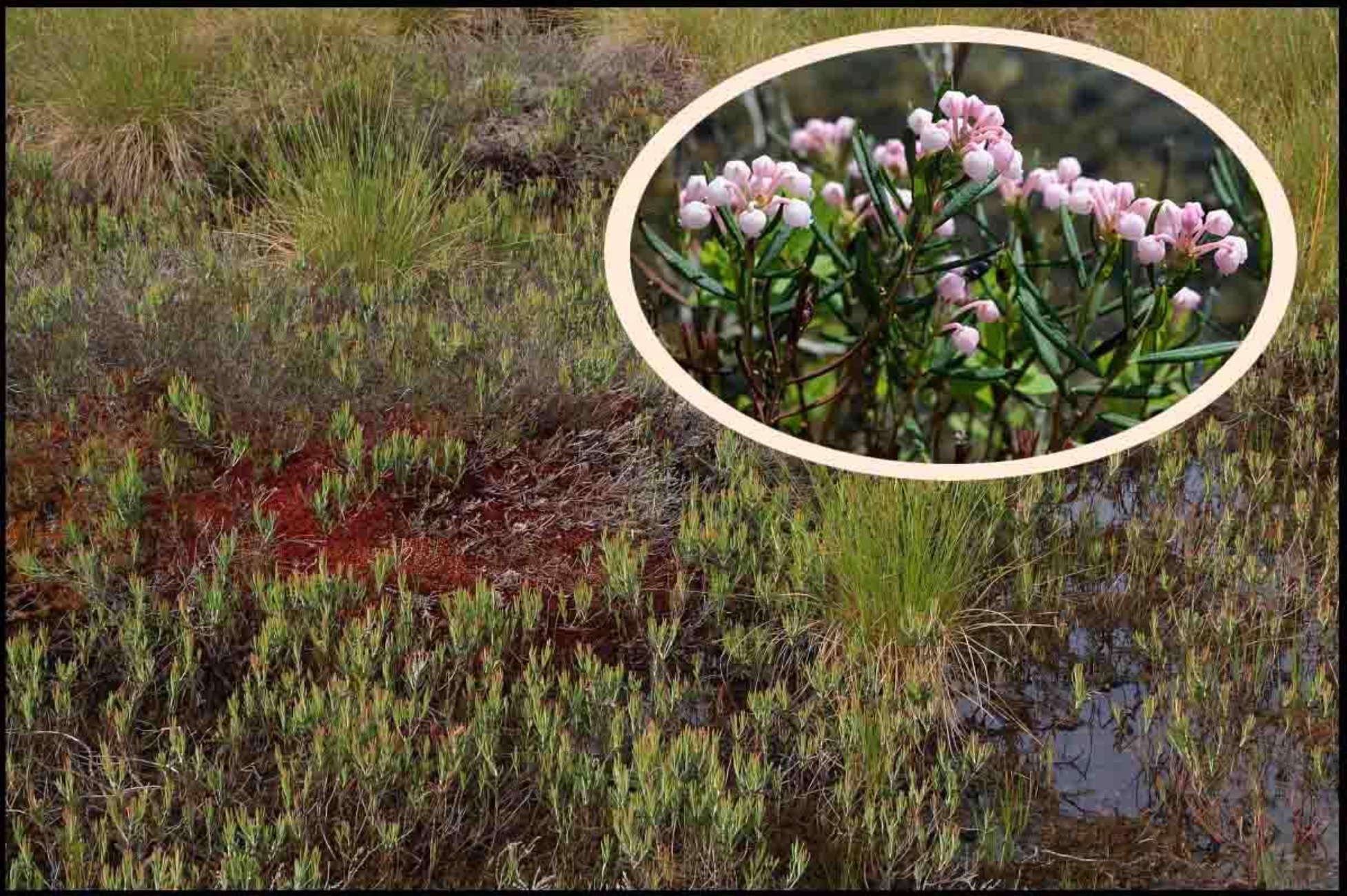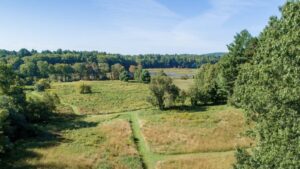
Needham History: Does Rosemary Grow at Rosemary Lake?
Admit it – it’s an earworm, and if you are over 50, you are humming it now. (“Love grows…”)
Or not.

Canoeing and fishing on Rosemary Lake, Circa 1920. The Carter Company’s Mill #2 is on the shore. The lake was used for recreation (fishing, boating, and swimming), for industry, and for ice-farming.
Does Rosemary Grow on Rosemary Lake?
There’s rosemary, that’s for remembrance…
(Hamlet, Act 4, Scene 5)
A few years ago, the town dredged the muck from the bottom of Rosemary Lake to remove some of the pollutants that had filtered in over the years (decades? centuries?). They also built the new pool complex, eliminating the need to drain the lake every spring. I know it is better this way, but I still kind of miss the month when the lake was drained – it was a magnet for birds, and herons, egrets, and even a bald eagle could be spotted hunting fish in the shallow pools.
Also visible along the drained lake bed was the old channel that used to be the Rosemary Brook. The Lake, in fact, is artificial. It is a shallow basin that was dug out in the early 19th century, fed by the Rosemary Brook and controlled by opening and closing a sluice gate.
Before Rosemary Lake there was the Rosemary (Rosemerry/Rosemery) Brook and its marshy streambed, the Rosemary Meadow. The term “meadow” is often used to designate any generic field or pasture, but more precisely it means the fields alongside rivers that were more or less constantly waterlogged. Wet meadows were highly valued because (1) they did not support woodland so did not have to be cleared for use, and because (2) cattle (the mainstay of Needham agriculture) needed the ample supply of water that they provided. Rosemary Brook and Rosemary Meadow are mentioned by these names in the Dedham records as early as 1648.
I have often wondered how the Brook/Meadow came to be called “Rosemary.” The culinary herb that we know – Salvia rosmarinus – does not grow wild in our climate. Rosemary is a Mediterranean native, and related to sage. Although it was introduced into northern Europe before the 13th century, it was only brought to America in the 1600s. Most varieties are not winter-hardy in this climate, and have to be grown as a cultivar rather than wild. Also, it requires drier soils and good drainage and cannot survive in the waterlogged environment of a meadow. Nostalgia perhaps? In medieval medicine, rosemary had many uses, and was thought to promote memory, so was used as a symbol of partings and bereavements. Perhaps the name harkened to the memory of family and villages left behind in England?
Or, a less romantic explanation is that the plant in question is actually the Bog Rosemary, or Wild Rosemary (Andromeda polifolia). Bog rosemary is native to this area, growing wild in the Northeast and upper Midwest, northward into Canada. It is not a relative of the rosemary herb; it is actually a relative of heather. It grows in low dense mats and thrives in soggy meadows. It is not edible; in fact, it is mildly poisonous. But it gets its name from the form and appearance of its leathery needle-like leaves, which strongly resemble those of the garden rosemary.
Bog, or Wild, Rosemary grows in low dense mats in soggy ground (lower left); in the spring it has small bell-shaped pink flowers (inset).

The Rosemary Brook runs from the Charles River near Lower Falls, through Longfellow Pond and the Wellesley Water Lands, into Rosemary Lake, and peters out in the marshy hollow at the bottom of May Street. The first pond along the Rosemary Brook was formed by damming the brook for a sawmill; the dam is mentioned in town records as early as 1718, so was presumably built before this date. The pond formed by the dam was called Rosemary Pond, though it is now known as Longfellow Pond, just over the town line in Wellesley.
The Rosemary Lake that we now know in Needham was created in 1831 by Lemuel Lyon for his beaver hat factory. The channel was dammed by building a sluice gate (which still exists under Rosemary Street) and the shallow basin was dug out to deepen it into a pond. Digging by hand, and removing the muck by horse and cart, took more than a year. When first built, the lake was known as Lyon’s Pond.
Lyon’s factory burned down in the 1840s and was rebuilt. By 1850, it was the silk mill of Lemuel Cobb, then (leaving out a few owners along the way) it became Galen Orr’s batting mill (1851), the Union Cycle Company (1888), Carter Company’s Mill # 2 (1902), and finally the Tillotson Rubber Company in 1935. Tillotson’s moved to New Hampshire, and the factory was demolished in 1971 and replaced by the current apartments.
But the lake was not just a resource for industry. People fished there. There was an ice house on its western shore (just about where the parking lot is now), and from the turn of the 20th century to about 1931, the Union Ice Company harvested ice on Rosemary Pond. On the southern end, residences took advantage of the lakeside views – notably the gracious estate of the Burrage family, known as Twin Oaks (now the site of Tamarack Lane). William Carter cleaned up the Pond after he purchased the mill, and installed a swan house and four swans; within a few years, the swans attracted other wildfowl to take up residence as well. Carter also had a small motor boat, which he ran on the pond.
More recently, the pond famously became Needham’s swimming hole, a project started in 1933. The original plan was to create a “beach” on the southern margin, but competition from private residential property moved the location to the northern edge, near Rosemary Street. When the pond was dredged, they cleared out the remnants of Carter’s swan house and the abandoned ice house, and deposited enough gravel and sand to create a 300-foot beach. The lake was used for swimming until 1970, when the water quality became unsafe from the deep accumulation of silt and the chemical runoff from the growing number of homes near the lake and the brook. The “temporary” lakeside pool was built a few years later, and lasted for 45 years before our new pool complex opened in 2018.
Rosemary Lake has been transformed, over the many years, from an industrial tool to a recreational amenity. No solution is perfect, but the recent dredging project was able to remove some of the damage from the Lake and Brook, and improve their ecological health. I look forward to resuming my summer lunch breaks, watching the ducks, herons, and egrets that frequent the lake. And if I’m lucky, maybe another eagle.
 |
Gloria Polizzotti Greis is the Executive Director of the Needham History Center & Museum. For more information, please see their website at www.needhamhistory.org. |

